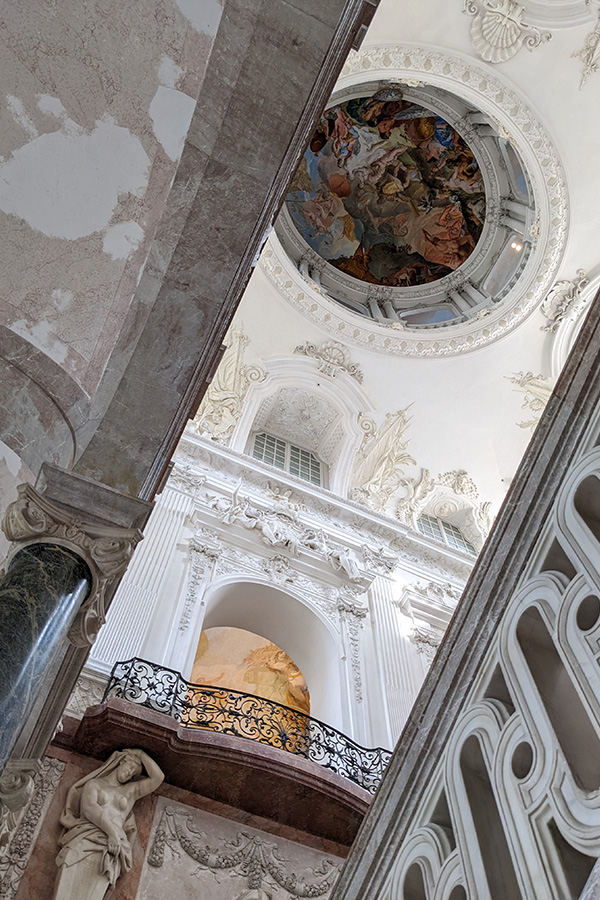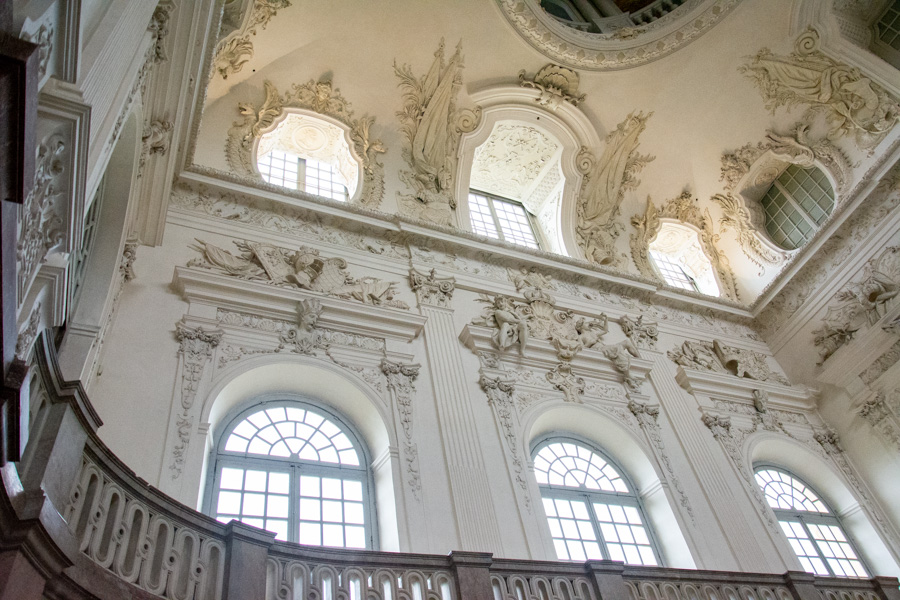Roughly halfway between the Munich airport and the city’s Altstadt, or “old town,” lies Schloss Schleissheim. Centuries ago, the site was merely some average farmland. Today, there are two palaces, a hunting lodge, and formal gardens that are absolutely ideal for strolling.
Although not hidden or unknown, Schleissheim Palace is often overshadowed by its nearby relatives: Bavarian palaces like Neuschwanstein or the Munich Residenz. While this palace doesn’t quite have the same word-of-mouth advertising, the quiet location is not an indication of what lies within. Visitors to the Bavarian capital – or even those temporarily at the airport for a layover who have some time to kill – can explore the complex, including the lavish new palace with its striking interior architecture.
A Brief History of Schloss Schleissheim
In the late 1590s, Duke Wilhelm V of Bavaria purchased what was then just some farmland with a chapel. By the end of the decade, he had built on the land a mansion, complete with a gate and a clock tower. When his son, Maximilian I, took over, he had different ideas about the palace.
Less than 20 years old, Maximilian I took the building that is now known as the Old Place (or Altes Schloss) down to the ground and rebuilt it. The architects behind the renovation are thought to be Hans Krumper and Heinrich Schön while Peter Candid is responsible for the stuccos and frescoes.
Fast forward to the 1670s when Elector Max Emanuel asked Swiss architect Enrico Zuccalli to build a garden palace and hunting lodge, the Lustheim Palace (or Schloss Lustheim in German), for him and his wife. By this time, Zuccalli had already put his fingerprint on Munich, with projects including the Theatinerkirche and the Residenz. The Lustheim Palace lies at the far end of the property with formal gardens creating a very linear barrier between it and the Old Palace.
Roughly two decades later, Elector Max Emanuel decided to build a new palace (the Neues Schloss) to serve as his residence. He called again upon Zuccalli. The plan was for a lavish four-wing palace that would connect to the Old Palace.
But in 1704, Max Emanuel was forced into exile as a result of the War of the Spanish Succession. Work on the palace, under the direction of architect Joseph Effner, resumed upon Max Emanuel’s return in 1715. By then, money was also becoming an issue and the plan was scaled back. Instead of connecting the two palaces, only a single wing was constructed.
When Max Emanuel died in 1726, the palace was still incomplete. The palace that was once anticipated to be so impressive was missing major architectural details, flooring, wall coverings, and so on. Over time, his successor and son, Karl Albrecht, put the finishing touches on the building.
Like so many places in Europe, and especially Germany, the Old Palace was destroyed nearly in its entirety during World War II. The palace was rebuilt in the 1970s.
Visiting Schleissheim Palace
Schloss Schleissheim is a great and extremely easy day trip from Munich. The real attraction is the New Palace. Although just a few lines above I say there were financial restraints, anyone who has seen the result of the New Palace would find that difficult to believe. The palace is deceptively large, with many rooms to see although most are only minimally furnished.
From the get-go, the building’s interior details will make your neck sore, as you gaze upward. The grand staircase near the entrance is ornately decorated with Baroque designs over three stories. And then high above, like the proverbial cherry on the sundae is a dome by Cosmas Damian Asam (of the famed Asamkirche) depicting Venus, the goddess of love, in the weaponsmith of Vulcan, the god of fire.
The walls, meanwhile, are covered in decorations with royal connotations, ornate flourishes, animals, and cheeky faces both real and imagined. Be sure to turn back around and look up – just above the entrance to the staircase from the main floor is a mustachioed man, staring sternly down upon those who dare tread beneath.
Paintings that nearly take up entire walls, ceilings covered in detailed frescoes, and tapestries cover nearly every wall throughout the New Palace. In the more than 180-foot-long Large Gallery, works of art cover the bold red interior wall while the wall opposite is punctuated by floor-to-ceiling windows that open onto the stunning formal gardens.
From a historic point of view, the Old Palace is not nearly as interesting as its successor. The rebuilt palace today serves as a satellite museum of the Bavarian National Museum. There are two permanent exhibits on display: “The religious year and its festivals” (Gertrud Weinhold Collection) and “There once was a land…”
Tips for Visiting
A visit to these Bavarian palaces can be tailored to your interests. Admission is required to enter each of the three palaces. You can purchase a combination ticket for all three. Alternatively, you can buy tickets individually, if you’re not interested in viewing all three. If you’re planning on visiting other palaces and castles in Bavaria, I recommend the Bavarian palace pass. The gardens surrounding the palaces are free and can be enjoyed year-round.
It’s also important to keep the time of year in mind with your visit. During my visit in early autumn, the gardens were an absolutely beautiful mix of trees with yellow, orange, and green leaves. But, the garden’s water fountains turn off for the season starting in mid-September.
Getting There
Reaching Schloss Schleissheim is relatively easy. With public transportation, the Oberschleissheim stop on the S1 line of Munich’s S-Bahn leaves you less than a half-mile from the palace complex. Visitors can then make the easy walk through the small town. Alternatively, a bus stop at the train station ferries riders to the palace. From central Munich, the S-Bahn ride is approximately 20 to 30 minutes; from the airport, it’s about 20 to 25 minutes.
For those who prefer to drive, there are more than 100 parking spaces available at the palace.
Save this post to Pinterest!
All photos, as well as opinions, are my own.











